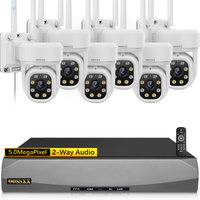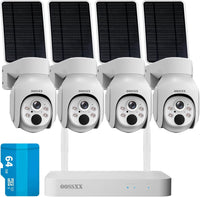Calculating the bandwidth and recording storage space for a surveillance camera system involves understanding several commonly used terms in surveillance video technology.
**Bitrate:**
Bitrate refers to the number of bits transmitted per second. A higher bitrate generally indicates better audio and video quality, but also results in larger file sizes. Conversely, a lower bitrate sacrifices quality to reduce file size.
**Data Rate (DataRate or Data Bandwidth):**
Data rate is the amount of data transmitted within a specific time interval, usually per second. In video encoding, data rate plays a vital role in controlling the quality of the video. A higher data rate leads to better quality but lower compression ratios.
**Upload Bandwidth:**
Upload bandwidth refers to the rate at which data is transferred from a local device to the network. It affects the speed at which users can send data to the network, such as uploading files.
**Download Bandwidth:**
Download bandwidth refers to the rate at which data is transferred from the network to a local device. It impacts the speed at which users can retrieve data from the network, such as downloading files.
To calculate the required bandwidth and storage space for a surveillance camera system, one must consider the number of cameras, their resolution, and the recording duration.
Let's take an example with two common video formats and resolutions:
**720P Resolution (1 Megapixel):**
- Bitrate per camera: 2 Mbps
- Number of cameras: 10
Total Upload Bandwidth Required:
2 Mbps (bitrate per camera) * 10 (number of cameras) = 20 Mbps
**1080P Resolution (2 Megapixels):**
- Bitrate per camera: 4 Mbps
- Number of cameras: 10
Total Upload Bandwidth Required:
4 Mbps (bitrate per camera) * 10 (number of cameras) = 40 Mbps
For the surveillance center:
Total Download Bandwidth Required:
- For 720P: 2 Mbps (bitrate per camera) * 50 (total number of cameras) = 100 Mbps
- For 1080P: 4 Mbps (bitrate per camera) * 50 (total number of cameras) = 200 Mbps
Recording Storage Space Calculation:
Storage space (in gigabytes) = Bitrate (in kilobits per second) * 3600 (seconds in an hour) * 24 (hours in a day) * 30 (number of days) * Number of Cameras / 0.9 (for disk formatting loss)
For example, to store 30 days of recording for 50 cameras using CIF video format:
Storage space (in gigabytes) = 64 kbps * 3600 * 24 * 30 * 50 / 0.9 = 8789.1 GB ≈ 9 TB
To store 30 days of recording for 50 cameras using D1 video format:
Storage space (in gigabytes) = 192 kbps * 3600 * 24 * 30 * 50 / 0.9 = 26.2 TB
As surveillance technology continues to evolve, it's essential to assess the required bandwidth and storage space accurately to ensure optimal performance and data retention. Brands like OOSSXX offer wireless security camera systems with motion detection and various resolutions, catering to different surveillance needs. From home security to advanced wireless systems, these solutions provide both reliability and flexibility in managing surveillance data.









